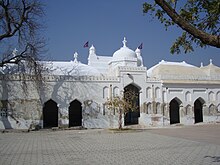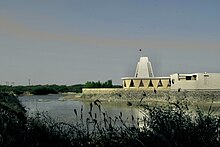Jhulelal (Hinduism)
[1][4] The reincarnation of a Sindhi deity, Jhulelal exhibited supernatural powers since childhood; he preached about how the Muslims believed in the same God, and emphasized that the Koran forbade forced conversion.
[1][2] Devotional songs were penned, pamphlets printed, statues installed, festivals celebrated, and cultural events organized in thousands for the cause of Jhulelal.
[2] In 1007 Vikram Samvat (950 CE), the day of Cheti Chand in Chaitra, Jhulelal was born to a local Hindu family of Lohana caste.
These latter returned with accounts of their witnessing strange events:[2] the child in question metamorphosed into a young warrior, then into an old man, before back into a child; at other times, he rode up the river on the back of a fish; he acted and spoke as if a sage, rather than a typical young boy; and performed various other feats before the disbelieving eyes of the advisors.
[2] The birth-name varies from Uderolal to Amarlal to Daryasahib; the event of his first appearance is either noted to be from a human birth or from the Indus, riding on a fish.
[2] The Cheti Chand festival in the month of Chaitra, marks the arrival of spring and harvest, as well as the incarnation day of Uderolal in the Vikram Samvat calendar year 1007.
[12][13] Nawabshah, Hyderabad, Matiari, Sanghar and Mirpur Khas are the nearby major cities to reach at the Shrine near Tando Adam.
[15][16] Sindhi Hindus in India built a religious shrine and cultural complex in Kutch in the Indian state of Gujarat, near the border of Sindh Province.
[6][17] Harish Fabiani, one of the key promoters of the project, stated regarding the cultural complex, "The younger generation is aware they are Sindhis, but they do not know their language.




